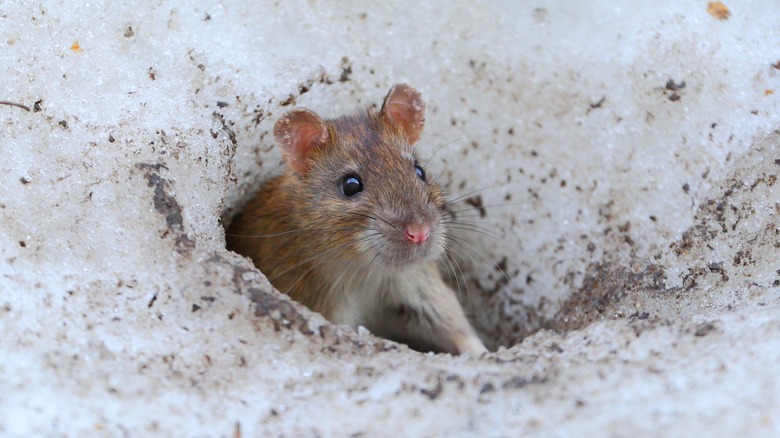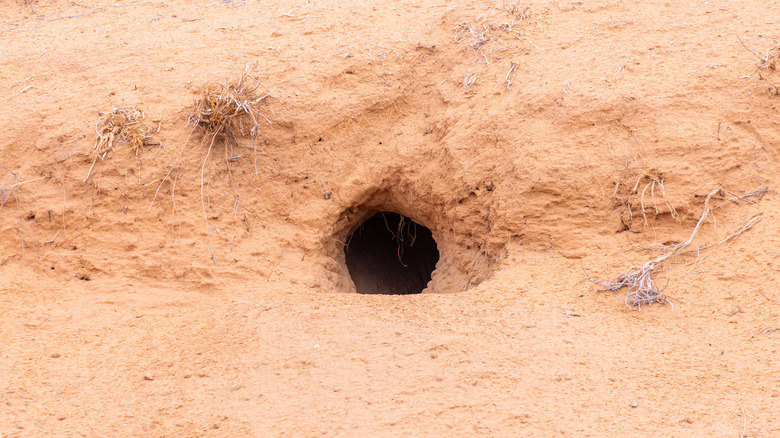Use TikTok's Quick Trick To Instantly Drive Rats Out Of Their Burrows In Your Yard
If you have rats invading your yard, they may be making burrows underground. Certain species of these pests create nests under the ground with multiple entrances and exits. Once these rodents are established in your yard, they may attempt to move into your home when the weather cools, leading to a pesky rodent problem. If you don't want these pests in your yard, but you also don't want to spread poison that could put pets and children in danger, you need a way to get rid of the rats humanely. TikTok user @twinhomeexperts has a hack that solves this problem quickly and safely. Just add liquid dish soap to one of the exit or entrance holes and then add water to create a foamy liquid.
Flooding the rats' tunnels convinces the rodents that a predator discovered the nest, which ensures they won't return. Adding water to the burrow also makes the space inhospitable in the future, as the tunnels may remain flooded for several days, further discouraging the pests from trying to take over the space.
Once you're sure that the rodents have abandoned the burrow, you can use a shovel to collapse the entrance and exit holes and pack down the dirt. Revisit the site after a few days. If the hole is open again, it means the pests are still active, so you may need to try to drive them away again.
How to use liquid dish soap to flood rats out of burrows on your property
To follow the TikTok hack, you start by finding one of the exit or entrance holes to the rodent's nest. Bring a garden hose and a bottle of liquid dish soap to the hole. Add a large amount of dish soap and water from the hose into the hole at the same time, creating a bubbly mixture that foams up quickly as it flows down into the hole. As shown in the TikTok video, within a few seconds, the rats run back out through the soapy mixture and vacate the hole. It is possible that the rats will run out of other holes connected to the burrow. If you would prefer them to run out the same hole where you are adding the water and dish soap, you would need to block off any other holes associated with this burrow before adding water.
When used normally, dish soap effectively removes grease, oils, and other organic particles from your plates and silverware. This means it will stick to the fur of the rats, which often have greasy spots. You can see these greasy trails in areas where rats may slide against a wall.
Dish soap is not toxic to the rats, so it's still a safe way to remove them from your yard. In fact, some people use dish soap to give their pet rats a bath, as long as they use a small amount.
How do I know if I am seeing rat burrows in my yard?
Before attempting this hack, you may want to be certain that you actually have rats burrowing on your property. Often, these pests will place their holes in sandy soil in areas where they are slightly hidden, such as underneath a bush, near thick vegetation, underneath a deck, or near a crawl space on your home's foundation. Inspect these areas for openings in the ground that are 2 to 4 inches in diameter. The interiors of the holes should be smooth with hard-packed dirt, and they should have small piles of dirt spread outside the holes in a fan pattern.
In an active burrow, these rodents do a good job of keeping the holes free from debris. If you are unsure whether the burrow is active, tuck some leaves or paper inside the opening. Come back in a day or two. If the opening is clear again, it is an active burrow. Additionally, you may see signs of fresh droppings near the exterior of the opening, which look like tiny black seeds that are shiny and are up to ¾ of an inch in length. Older droppings turn gray in color.
Because some species of mice, moles, and voles also make burrows under the ground, you could be seeing signs of these pests instead of rats. The good news is that you can also use the TikTok hack and liquid dish soap to drive these pests out without poison.

